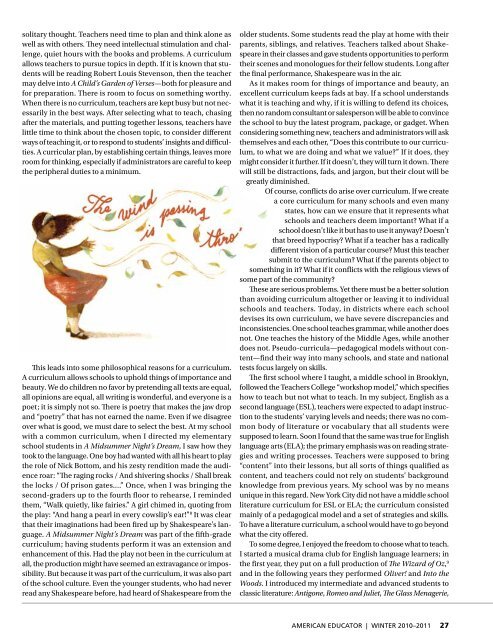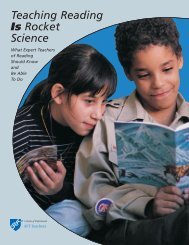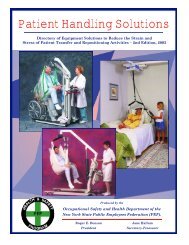American Educator, Winter 2010-11, Vol. 34, No. 4, AFT
American Educator, Winter 2010-11, Vol. 34, No. 4, AFT
American Educator, Winter 2010-11, Vol. 34, No. 4, AFT
You also want an ePaper? Increase the reach of your titles
YUMPU automatically turns print PDFs into web optimized ePapers that Google loves.
solitary thought. Teachers need time to plan and think alone as<br />
well as with others. They need intellectual stimulation and challenge,<br />
quiet hours with the books and problems. A curriculum<br />
allows teachers to pursue topics in depth. If it is known that students<br />
will be reading Robert Louis Stevenson, then the teacher<br />
may delve into A Child’s Garden of Verses—both for pleasure and<br />
for preparation. There is room to focus on something worthy.<br />
When there is no curriculum, teachers are kept busy but not necessarily<br />
in the best ways. After selecting what to teach, chasing<br />
after the materials, and putting together lessons, teachers have<br />
little time to think about the chosen topic, to consider different<br />
ways of teaching it, or to respond to students’ insights and difficulties.<br />
A curricular plan, by establishing certain things, leaves more<br />
room for thinking, especially if administrators are careful to keep<br />
the peripheral duties to a minimum.<br />
This leads into some philosophical reasons for a curriculum.<br />
A curriculum allows schools to uphold things of importance and<br />
beauty. We do children no favor by pretending all texts are equal,<br />
all opinions are equal, all writing is wonderful, and everyone is a<br />
poet; it is simply not so. There is poetry that makes the jaw drop<br />
and “poetry” that has not earned the name. Even if we disagree<br />
over what is good, we must dare to select the best. At my school<br />
with a common curriculum, when I directed my elementary<br />
school students in A Midsummer Night’s Dream, I saw how they<br />
took to the language. One boy had wanted with all his heart to play<br />
the role of Nick Bottom, and his zesty rendition made the audience<br />
roar: “The raging rocks / And shivering shocks / Shall break<br />
the locks / Of prison gates....” Once, when I was bringing the<br />
second-graders up to the fourth floor to rehearse, I reminded<br />
them, “Walk quietly, like fairies.” A girl chimed in, quoting from<br />
the play: “And hang a pearl in every cowslip’s ear!” 8 It was clear<br />
that their imaginations had been fired up by Shakespeare’s language.<br />
A Midsummer Night’s Dream was part of the fifth-grade<br />
curriculum; having students perform it was an extension and<br />
enhancement of this. Had the play not been in the curriculum at<br />
all, the production might have seemed an extravagance or impossibility.<br />
But because it was part of the curriculum, it was also part<br />
of the school culture. Even the younger students, who had never<br />
read any Shakespeare before, had heard of Shakespeare from the<br />
older students. Some students read the play at home with their<br />
parents, siblings, and relatives. Teachers talked about Shakespeare<br />
in their classes and gave students opportunities to perform<br />
their scenes and monologues for their fellow students. Long after<br />
the final performance, Shakespeare was in the air.<br />
As it makes room for things of importance and beauty, an<br />
excellent curriculum keeps fads at bay. If a school understands<br />
what it is teaching and why, if it is willing to defend its choices,<br />
then no random consultant or salesperson will be able to convince<br />
the school to buy the latest program, package, or gadget. When<br />
considering something new, teachers and administrators will ask<br />
themselves and each other, “Does this contribute to our curriculum,<br />
to what we are doing and what we value?” If it does, they<br />
might consider it further. If it doesn’t, they will turn it down. There<br />
will still be distractions, fads, and jargon, but their clout will be<br />
greatly diminished.<br />
Of course, conflicts do arise over curriculum. If we create<br />
a core curriculum for many schools and even many<br />
states, how can we ensure that it represents what<br />
schools and teachers deem important? What if a<br />
school doesn’t like it but has to use it anyway? Doesn’t<br />
that breed hypocrisy? What if a teacher has a radically<br />
different vision of a particular course? Must this teacher<br />
submit to the curriculum? What if the parents object to<br />
something in it? What if it conflicts with the religious views of<br />
some part of the community?<br />
These are serious problems. Yet there must be a better solution<br />
than avoiding curriculum altogether or leaving it to individual<br />
schools and teachers. Today, in districts where each school<br />
devises its own curriculum, we have severe discrepancies and<br />
inconsistencies. One school teaches grammar, while another does<br />
not. One teaches the history of the Middle Ages, while another<br />
does not. Pseudo-curricula—pedagogical models without content—find<br />
their way into many schools, and state and national<br />
tests focus largely on skills.<br />
The first school where I taught, a middle school in Brooklyn,<br />
followed the Teachers College “workshop model,” which specifies<br />
how to teach but not what to teach. In my subject, English as a<br />
second language (ESL), teachers were expected to adapt instruction<br />
to the students’ varying levels and needs; there was no common<br />
body of literature or vocabulary that all students were<br />
supposed to learn. Soon I found that the same was true for English<br />
language arts (ELA); the primary emphasis was on reading strategies<br />
and writing processes. Teachers were supposed to bring<br />
“content” into their lessons, but all sorts of things qualified as<br />
content, and teachers could not rely on students’ background<br />
knowledge from previous years. My school was by no means<br />
unique in this regard. New York City did not have a middle school<br />
literature curriculum for ESL or ELA; the curriculum consisted<br />
mainly of a pedagogical model and a set of strategies and skills.<br />
To have a literature curriculum, a school would have to go beyond<br />
what the city offered.<br />
To some degree, I enjoyed the freedom to choose what to teach.<br />
I started a musical drama club for English language learners; in<br />
the first year, they put on a full production of The Wizard of Oz, 9<br />
and in the following years they performed Oliver! and Into the<br />
Woods. I introduced my intermediate and advanced students to<br />
classic literature: Antigone, Romeo and Juliet, The Glass Menagerie,<br />
AMERICAN EDUCATOR | WINTER <strong>2010</strong>–20<strong>11</strong> 27





